Pyrite vs Gold: Key Differences and Insights
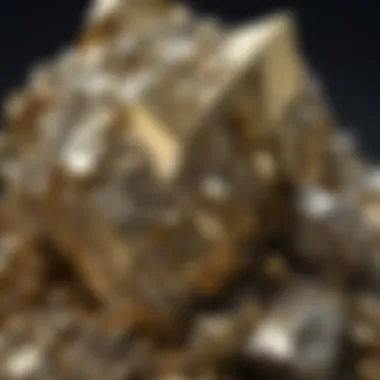
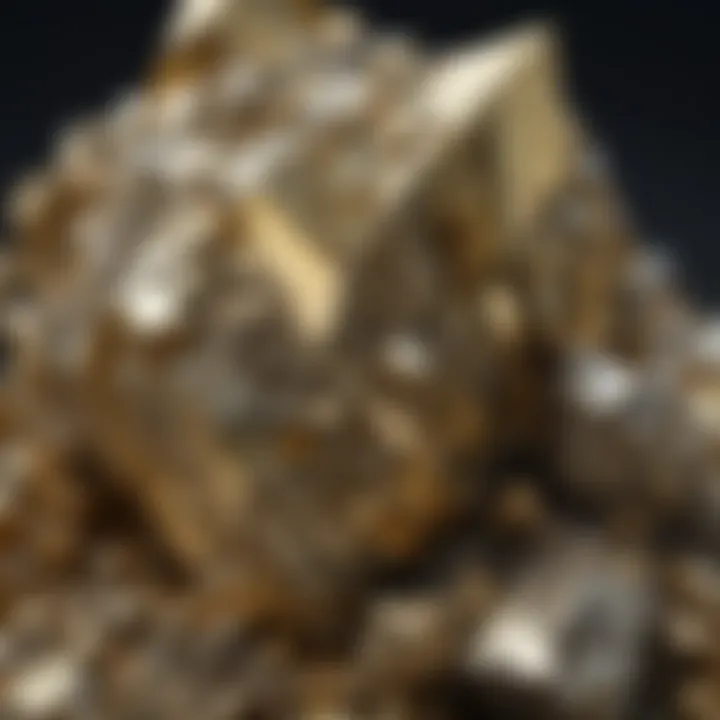
History and Origins
Understanding the foundations of our world often leads us to the intriguing tales of minerals that have shaped cultures and economies. Pyrite and gold, while both etched in the geological chronicles, have vastly different paths and impacts.
Overview of Collectibles, Rocks, and Fossils
The allure of pyrite and gold extends far beyond their aesthetic appeal. Collectors often seek both minerals not only for their beauty but also for their historical significance. Pyrite, known as "fool's gold" because of its misleading resemblance to gold, has been a centerpiece in various collections. Its shimmering, metallic luster captures the eye, leading many to mistake it for its more valuable counterpart. Gold, by contrast, has been revered throughout history, considered a standard for wealth and prosperity.
Historical Significance and Cultural Impact
The tale of pyrite dates back to ancient civilizations, where it was used for flint and as a decorative element. Indigenous people across the Americas valued it, integrating it into rituals and adornments. Gold's history is rich and often filled with lore—from the ancient Egyptians who adorned their tombs with gold artifacts to the reckless search for gold during the California Gold Rush. The significance of gold in society cannot be understated; it has symbolized power, wealth, and the divine.
"Gold is the treasure and key of all that is beautiful; Pyrite is the mirror of false promise."
Collectors today still seek these minerals, each carrying its own narrative. The markets for pyrite and gold are informative of their places in history and culture. The fascination surrounding these minerals illustrates humanity's ongoing relationship with the earth's resources and the stories embedded within them.
Identification and Classification
Identifying and classifying minerals can be a nuanced art, particularly when distinguishing between pyrite and gold. The subtleties of color, luster, and physical properties play a crucial role in accurate identification.
Guide to Identifying Rocks and Fossils
A clear distinction between pyrite and gold can be made by observing certain characteristics:
- Color: While both minerals share a yellowish hue, gold often exhibits a deeper and richer color. In contrast, pyrite has a brassy-yellow appearance.
- Luster: Gold's luster is typically more lustrous and reflective. Pyrite often appears more dull in comparison.
- Hardness: On the Mohs scale, gold ranks around 2.5 to 3.0 while pyrite ranks at 6 to 6.5.
- Streak: A streak test can be telling; pyrite leaves a greenish-black streak, whereas gold leaves a yellow streak.
Common Types and Variations
When diving into the world of pyrite and gold, one can find various forms:
- Pyrite: Found in a cubical form, often with "fools gold" crystals, pyrite can also appear as flat discs.
- Gold: Native gold appears in nuggets, flakes, or sometimes as wire, reflecting its formation process.
Prolusion to Pyrite and Gold
The interplay between pyrite and gold is not just a tale spun from the threads of chance; it's a narrative steeped in natural beauty, scientific interest, and historical value. Understanding the distinctions between these two minerals is essential for rock and fossil collectors who delve deep into the fascinating world of geology. This article sets out to illuminate not only the physical differences between pyrite, often dubbed "fool's gold," and the much-prized gold itself but also their broader implications in industry, history, and culture.
An in-depth analysis of both pyrite and gold reveals insights that may not be immediately apparent. For instance, while pyrite shares a similar luster with gold, its composition and behavior contrast sharply with the noble metal. This section lays the groundwork for that exploration, highlighting crucial aspects such as their definitions, historical contexts, and the significant roles they have played in human culture.
Definition and Overview
Pyrite is an iron sulfide with the chemical formula FeS₂. It crystallizes in the isometric system, leading to a distinctive cube shape that often gives it away as a mineral of interest. Its metallic luster and pale brass-yellow hue can easily trick the unwary into mistaking it for gold. Conversely, gold is a pure elemental metal, symbolized as Au on the periodic table, known not only for its striking color but also for its malleability and conductivity. Gold's unique properties make it a cornerstone for currency, jewelry, and various industrial applications.
What sets these two minerals apart? While both are striking, their chemical structures and behavior in the natural world differ significantly. Pyrite doesn’t hold valuable economic properties like gold, leading to their often high-stakes interactions in various sectors.
Historical Significance
To understand the importance of pyrite and gold, one must wander through the corridors of history. Gold has long been a symbol of wealth and power, with archeological findings suggesting its use in ancient Egypt as far back as 3000 BC. Gold artifacts, from decorative items to burial masks, demonstrate its revered status.
In contrast, pyrite, while used throughout history in various applications, has often been undervalued. During the California Gold Rush, for instance, miners often found pyrite among the debris—its misleading appearance fueling hopes of striking it rich. This led to an era of harsh lessons, as the seekers would realize that not all that glitters is gold.
Collectively, these minerals offer a fascinating lens through which to view economic, cultural, and technological developments across time. As we embark on the journey to juxtapose their characteristics in subsequent sections, it’s vital to appreciate the roles that pyrite and gold play—not just in geology but also within human narrative.
Physical Properties of Pyrite and Gold
When delving into the characteristics that set pyrite apart from gold, one must first appreciate the physical properties of these minerals. Understanding these properties is crucial not just for geological classification, but also for practical applications in various fields, from jewelry making to industrial uses. Each mineral's distinctive traits can influence its economic value and its role in cultural symbolism.
Color and Luster
At first glance, the color and luster of a mineral can provide immediate clues to its identity. Gold is well-known for its rich, yellow hue and shiny, metallic luster. This flashy appearance has captured human attention for centuries, making it a sought-after metal in both art and currency. On the other hand, pyrite, often referred to as "fool's gold," exhibits a brass-yellow color that can easily mislead the untrained eye. Pyrite's luster is metallic as well, but its shine can sometimes appear duller compared to the vivid brilliance of gold.
- Key Differentiators:
- Color:
- Luster:
- Gold: Rich yellow, can vary with alloys.
- Pyrite: Brass-yellow, more muted.
- Gold: Bright, reflective, and smooth.
- Pyrite: Metallic but sometimes less bright.
"Seeing is believing, but in the world of minerals, even that can be deceiving."
The implications of these differences are significant. Jewelers and collectors often need to rely on these visual cues when assessing the authenticity of a material. Moreover, the color and luster of these minerals also affect their desirability and market value.
Hardness and Density
Next, let’s touch on hardness and density, fundamental properties that help in identifying minerals. Gold scores a 2.5 to 3 on the Mohs scale of mineral hardness, making it relatively soft and easily malleable. This quality allows it to be shaped into intricate designs, an aspect that jewelers greatly appreciate.
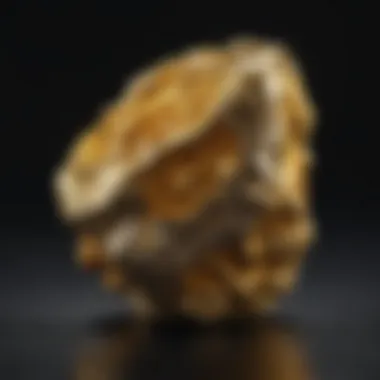
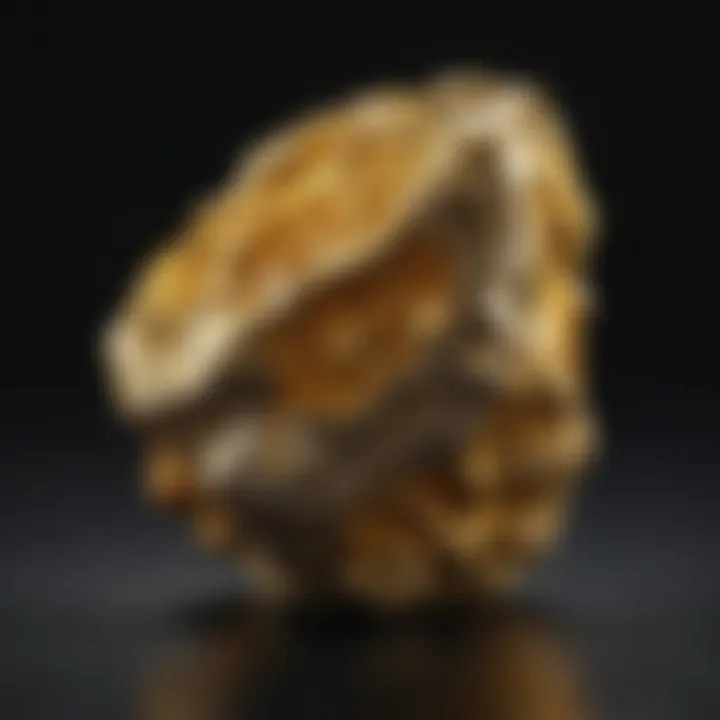
Conversely, pyrite boasts a hardness rating of 6 to 6.5, which makes it quite a bit tougher. This resilience adds an interesting twist, especially when the two minerals are compared side-by-side. Moreover, regarding density, gold weighs in at about 19.32 g/cm³, making it one of the densest naturally occurring materials. Pyrite’s density is significantly lower, around 5.0 g/cm³, which can aid collectors in distinguishing between the two.
- Comparison of Hardness:
- Comparison of Density:
- Gold: 2.5-3 (soft, malleable)
- Pyrite: 6-6.5 (harder, less malleable)
- Gold: 19.32 g/cm³ (heavy and dense)
- Pyrite: 5.0 g/cm³ (lighter by comparison)
These properties not only assist in identification but also dictate how each mineral is used in various applications. For instance, gold’s malleability is why it’s favored in fine jewelry, while pyrite is often used in industrial applications such as sulfur production and as a source of iron.
Crystal Structure
The crystal structure of these minerals presents yet another perspective on their distinctiveness. Gold typically crystallizes in a cubic system, showing a tendency to form well-formed, octahedral crystals. This structural property plays a role in its physical appearance and how it interacts with light, contributing to its allure.
In contrast, pyrite also crystallizes in a cubic system but forms distinct, well-defined crystals that are often more angular and sharper in appearance. These pyrite crystals can exhibit a unique "striking" shape, often reminiscent of a cube.
- Structural Summary:
- Gold:
- Pyrite:
- Crystal system: Cubic
- Formation: Smooth and rounded facets
- Crystal system: Cubic
- Formation: Sharp, angular crystals that can resemble cubes
Understanding the nuances between their crystal structures is invaluable for mineral collectors and geologists alike, as it allows for more accurate identification in the wild. Whether you are assessing specimens for personal collections or for educational purposes, these physical properties serve as foundational elements for distinguishing between pyrite and gold.
Chemical Composition
Understanding the chemical composition of pyrite and gold is crucial in appreciating their differences and significance in various fields, including geology, mineralogy, and investment. This section explores how the specific elements that make up these two minerals affect their properties, uses, and overall value.
Elemental Analysis
Pyrite, commonly known as Fool's Gold, is primarily composed of iron and sulfur, with the chemical formula FeS2. It contains approximately 46.6% iron and 53.4% sulfur, contributing to its metallic luster and yellow hue. On the other hand, gold is a pure elemental metal, represented by the symbol Au on the periodic table. Gold is renowned for its malleability and resistance to tarnish, characterized by a very high atomic number of 79.
The presence of these elements not only defines their physical characteristics but also significantly influences their applications. For instance, pyrite is often used in the production of sulfuric acid and as a semiconductor material. Gold, due to its superior electronic and thermal conductivity, is extensively used in electronics, jewelry, and even dentistry.
"The chemical properties of minerals dictate their usability and value in industrial and ornamental applications."
Stability and Reactivity
When delving into stability and reactivity, significant differences emerge between pyrite and gold. Pyrite is less stable than gold, particularly in the presence of moisture and oxygen, which can lead to its oxidation. This process generally results in the formation of sulfuric acid, contributing to environmental concerns during mining operations. Moreover, pyrite can undergo slow weathering, leading to a more reactive state where it may contribute to acid mine drainage.
Conversely, gold is inert with respect to most chemical reactions. It does not tarnish or corrode, which is why it can withstand harsh environments (like those found in some underwater ecosystems) without losing its luster. Its robust nature makes it an ideal material for prolonged use in jewelry and electronics, as well as a stable investment choice during economic fluctuations.
In summary, the chemical composition of pyrite and gold distinguishes their characteristics and impacts their industrial relevance, environmental interactions, and overall value. A deeper understanding of these elements provides insight into their applications and the misconceptions that surround them.
Economic Importance
The economic significance of pyrite and gold is multi-faceted, intricately woven into the fabric of markets, industries, and even societal developments. Both minerals hold distinct roles within various sectors, driving advancements and sometimes causing upheavals. Understanding this economic terrain offers insights into not only their intrinsic values but also the broader implications for collectors, investors, and industry professionals alike.
Market Value Comparison
When it comes to market values, gold is the heavyweight champion, historically commanding prices that leave pyrite’s valuation in the dust. The stark contrast in worth stems from several factors:
- Rarity: Gold is considerably rarer than pyrite. While both can be found in natural deposits, gold prices skyrocket due to its limited availability.
- Demand: Gold has stood the test of time as a universal store of value, used in finance and currency. Meanwhile, pyrite, often dubbed 'fool's gold', mainly serves niche markets.
- Market Trends: The fluctuations in gold prices are heavily influenced by global economic indicators, while pyrite remains more stable, reflecting modest demand.
For example, as of 2023, gold prices have soared well above $1,800 per ounce, while pyrite tends to sell for under $1 per ounce, revealing a significant divergence in worth.
Applications in Industry
Although pyrite is often seen as somewhat lesser than gold, its economic relevance should not be underestimated. Pyrite finds utility in various industries. Here are some notable applications:
- Sulfide Source: Pyrite is a critical source of sulfur for the production of sulfuric acid, which is essential in fertilizer manufacturing.
- Metal Recovery: In mining, it serves as a valuable ore by providing iron. The mining industry often processes this mineral to extract valuable metals such as gold and copper.
- Electronics and Batteries: Research into pyrite’s semiconductor performance suggests future applications in electronics, namely in solar cells and batteries.
- Historical Chemistry: In alchemical practices, it was considered a significant material for transforming bases into noble metals.
Conversely, gold's applications include:
- Jewelry: Used widely in luxurious ornaments and embellishments.
- Electronics: Due to its superior conductivity, it is essential for high-end electrical components.
- Medical Devices: Gold's biocompatibility makes it ideal for various healthcare applications, from dental work to advanced medical implants.
Both gold and pyrite have played crucial roles in the industrial progression, yet their trajectories diverge sharply in both valuation and sectoral applications.
In summary, the economic importance of pyrite and gold extends beyond mere financial metrics; it encapsulates historical narratives, cultural impacts, and future innovations. Understanding these aspects is essential for collectors and industry professionals who wish to navigate the complex landscape of minerals effectively.
Identification Techniques
When exploring the differences between pyrite and gold, the ability to identify each mineral correctly is paramount. This identification not only aids collectors in assessing their acquisitions but also serves geological and economic purposes. Using precise identification techniques, enthusiasts can distinguish between these two minerals and avoid the common pitfall of mistaking one for the other. Whether for personal collections or academic study, mastering these methods can streamline the process and enhance one's understanding of mineralogy.
Visual Inspection
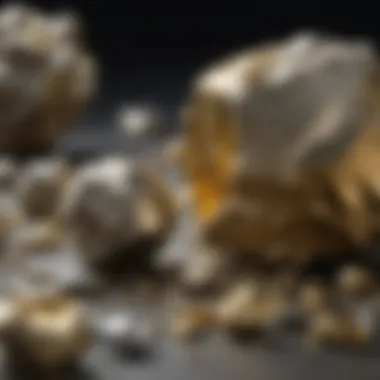
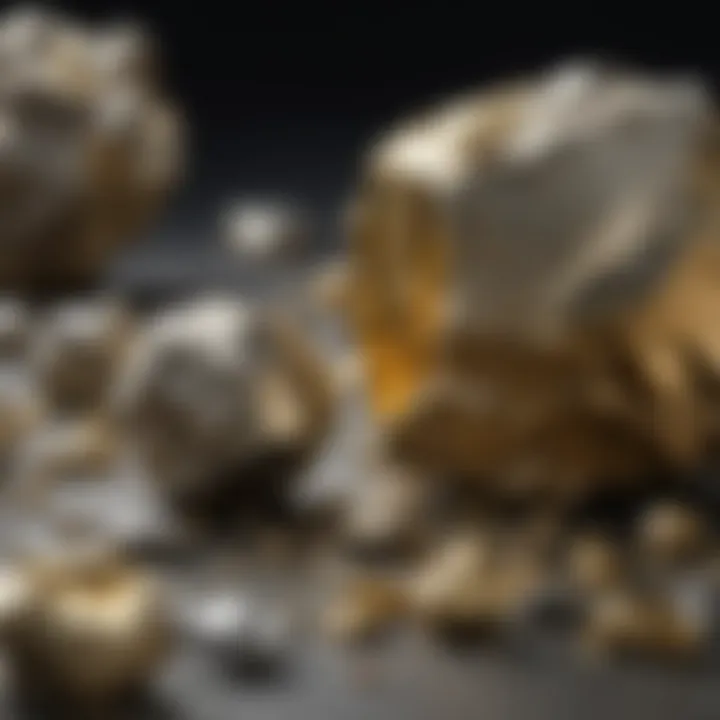
Visual inspection might sound simple, but it's an essential starting point in identifying pyrite and gold. The differences in color and luster are often the first giveaway. Gold radiates a rich yellow hue with a soft, metallic shine, while pyrite boasts a brassy shade with a sparkly, reflective quality that can fool even seasoned collectors.
Examine the surface as well:
- Gold is typically malleable and can be scratched by a knife, whereas pyrite will resist scratching and may produce powdery residue when scraped.
- Furthermore, gold will appear as a solid nugget, while pyrite often occurs in crystal form with distinct shapes.
A simple glance can often seal the deal, but it shouldn’t be solely trusted; after all, the eyes may deceive.
Chemical Tests
Chemical tests provide a reliable way to confirm findings from visual inspection. These methods can vary from simple home tests to more comprehensive laboratory analyses.
One well-known method is the acid test. A drop of nitric acid applied to the samples gives insightful results:
- If the substance reacts and turns green or white, it’s likely pyrite. Gold, showing no reaction, remains pristine.
- Additionally, other compounds can aid in identifying subtle nuances: for instance, potassium cyanide can differentiate gold’s unique characteristics further, since it will solubilize gold, but leave pyrite intact.
Such tests must be applied with caution and proper safety measures, as many chemicals can be dangerous. Yet the accuracy they afford can save money and disappointment down the line.
Advanced Analytical Methods
X-ray Diffraction
X-ray diffraction (XRD) is an intricate technique that can reveal the crystalline structure of a specimen, thus aiding in accurate identification of pyrite and gold. This method shines in its ability to pinpoint minerals based on their unique diffraction patterns. Each material’s atomic arrangement scatters X-rays in a specific way, leading to conclusive results.
- The key characteristic of X-ray diffraction lies in its precision. It’s widely recognized for producing reliable data that can distinguish closely related minerals, including various forms of pyrite and other sulfides.
- A unique feature of XRD is its non-destructive nature. Unlike some other methods, it won’t damage the sample, making it advantageous for collectors wanting to preserve their pieces.
However, it does require specialized equipment and trained personnel, which can pose a limitation for hobbyists.
Scanning Electron Microscopy
Scanning electron microscopy (SEM) offers a high-resolution image of mineral surfaces, thus assisting in the identification process. This approach allows for detailed examinations of the textures and structures of pyrite and gold at a microscopic level.
- The noteworthy characteristic of SEM is its depth of analysis; it provides elemental composition data through energy dispersive X-ray spectroscopy (EDS) along with high-magnification imaging. This offers a clearer picture of whether a specimen is genuine gold or fool’s gold.
- An interesting feature is SEM's ability to generate 3D images, revealing the intricacies of a mineral's surface that a traditional microscope could miss.
Yet, like X-ray diffraction, this method can be quite costly and is typically found in research labs, potentially outside the reach of most collectors.
In sum, the amalgamation of these identification techniques—ranging from the straightforward to the complex—equips mineral enthusiasts with the necessary tools to differentiate between pyrite and gold. With proper knowledge and skill, collectors can safeguard both their investments and their reputations in the mineral community.
Cultural Significance
When we talk about cultural significance in the context of pyrite and gold, we open a window into a rich tapestry of human history and expression. These two minerals are not just geological wonders; they are steeped in narratives that shape art, beliefs, and traditions across various societies. Understanding their roles can enrich our appreciation for them, especially for those who collect these stones.
Role in Art and Jewelry
Gold has long been the darling of artisans, prized for its malleability, stunning luster, and resistance to tarnish. From ancient Egyptian tombs filled with golden treasures to modern jewelry aesthetics, gold symbolizes wealth and prestige. Its warm hue has inspired jewelers to craft intricate pieces that often tell stories or commemorate significant events.
On the other hand, pyrite, with its metallic sheen and reflective qualities, while often overlooked for more traditional gemstones, has found its niche. Artists have incorporated pyrite into various forms of jewelry, utilizing its striking resemblance to gold to create pieces that capture the eye.
- Unique Compositions: Pyrite's brassy appearance provides a bold contrast in jewelry designs. It's become popular in bohemian styles, where its earthiness connects with the principles of sustainability.
- Artistic Exploration: Some artists use pyrite in sculptures and mixed media works, tapping into its geological origins to communicate larger themes of nature and deception. The duality of gold's allure versus pyrite's fool's gold status raises questions about value and perception.
Symbolism and Folklore
Throughout history, both of these minerals have inspired a wealth of folklore and symbolism. Gold is often associated with divine qualities, related to the sun and the eternal. Many cultures view it as a symbol of purity, perfection, and the divine right to rule, making it a staple in ceremonies and religious artifacts.
Conversely, pyrite holds a much more layered narrative. Often referred to as "fool's gold," the stone carries connotations of trickery and deception. This nickname reminds collectors and enthusiasts alike that appearances can be misleading.
"Not everything that glitters is gold." This age-old saying encapsulates the essence of pyrite’s place in cultural discussions, aligning with stories told through generations that warn against the allure of something that may not hold true value.
In numerous traditions, pyrite is viewed as a powerful protective stone. Some cultures believe it wards off negativity and is a symbol of strength and confidence, often carried as a talisman.
Understanding the symbolism behind both gold and pyrite not only enhances one's collecting experience but deepens the appreciation for their stories—a narrative woven through human history, art, and belief systems.
Environmental Considerations
When discussing pyrite and gold, it's vital to take into account the environmental impacts related to their extraction and use. These factors play a significant role in shaping the future of both minerals, as awareness grows regarding responsible mining practices and sustainability in the industry. As civilization continues to push for progress, the effects of mining activities on ecosystems cannot be ignored. Understanding the environmental implications of extracting pyrite and gold is crucial for collectors and enthusiasts alike, allowing them to make informed decisions that align with their values.
Extraction Impact
The extraction of both pyrite and gold can leave behind a trail of destruction. Often, mining operations disturb large swathes of land, leading to habitat destruction and soil erosion. Those who dig into the earth for these minerals often use methods that can cause pollution, which may leach toxic chemicals into nearby water sources. For instance, gold mining frequently utilizes cyanide in the extraction process, which poses a danger to aquatic life if not managed carefully.
Pyrite, while less valued economically, can bring its own set of environmental concerns. When it oxidizes, it produces sulfuric acid, which can lead to acid mine drainage, severely impacting local ecosystems.
The consequences of these extraction activities extend beyond the immediate area. They can affect downstream water quality and disrupt the lives of communities relying on natural resources for drinking water and agriculture.
"It often takes generations to heal the scars left by mining, as ecosystems are slow to recover from the disturbances caused by your typical extraction methods."
Prioritizing awareness of these impacts is essential; collectors can advocate for responsible sourcing and demand transparency from dealers regarding the origins of their specimens.
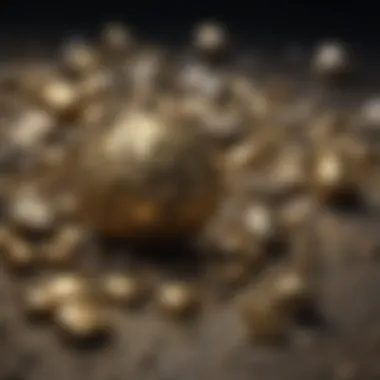

Sustainability Practices
In the ever-changing landscape of mineral extraction, sustainability practices have emerged as a necessary counterbalance to the challenges faced by the industry. These methods address the environmental degradation often associated with pyrite and gold mining.
Consider the following practices that can help mitigate harmful effects:
- Reclamation Efforts: Companies are now required to restore mined areas once extraction is complete. This involves replanting native vegetation and rehabilitating habitats.
- Water Management: Developing closed-loop systems to minimize water usage and prevent pollution from toxic runoff can help protect local water bodies. Mining companies are investing in quality treatment facilities to ensure waste does not harm local ecosystems.
- Responsible Sourcing: Many consumers are beginning to ask where their gold and pyrite come from. It’s significant for miners to prove they’re adhering to ethical extraction methods, reducing their environmental footprint.
- Innovative Technologies: Advancements in extraction technology, such as bioleaching, use bacteria to extract metals, significantly reducing the need for harsh chemicals.
Ultimately, embracing these practices will not only benefit the environment but can also enhance the long-term viability of extraction industries. Rock and fossil collectors can take pride in supporting more sustainable methods, setting an example for future generations.
By acknowledging the importance of environmental considerations in the discussion of pyrite and gold, readers can possess a more nuanced understanding of their choices in collecting and investment practices.
Misconceptions and Myths
The realm of mineralogy is not just a collection of rocks and gems; it’s also steeped in misunderstandings and legends that shape public perception. Addressing misconceptions and myths surrounding pyrite and gold is crucial to this article. This section aims to clarify these mistaken beliefs, providing rock and fossil collectors with a deeper grasp of these minerals' realities. Misinterpretations about their value, characteristics, or origins can mislead collectors and enthusiasts alike. By dissecting these ideas, one can foster a more thorough understanding of both pyrite and gold.
Gold Fever vs Fool’s Gold
The term "fool's gold" commonly refers to pyrite, a name that itself carries a weight of misconceptions. When prospectors rushed to strike gold, the shimmering allure of pyrite often deceived them, leading to significant disappointment. This term reflects not just a misidentification but also the emotional stakes involved in mining and prospecting.
- Shiny but Not Valuable: Many believe that all shiny rocks are gold. While pyrite has a metallic luster, it is distinct from gold in both chemical composition and value. Pyrite consists of iron sulfide, while gold is a pure metal that gleams with a warm, golden hue that pyrite can only simulate.
- Historical Context: During the 19th-century gold rushes, countless dreams were dashed upon the rocks of pyrite. In many instances, this led to tales of individuals losing fortunes, reinforcing the myth that pyrite could somehow hold the same value or importance as gold.
While ‘gold fever’ captures the essence of excitement, it’s also a reminder of the pitfalls that await those who do not distinguish between the two minerals. Understanding these differences not only protects collectors from making poor investments but also enriches their appreciation for the beauty and complexity of natural minerals.
Pyrite’s Legitimacy
Despite being labeled as fool's gold, the legitimacy of pyrite shouldn't be underestimated. While it may lack the value of gold, pyrite has its own unique characteristics and applications worthy of acknowledgment.
- Industrial Applications: Pyrite is mainly used in the production of sulfur dioxide for the paper and chemical industries. This practical use frames its value in non-monetary terms, showing that it holds significance within various contexts.
- Collectible Appeal: For rock collectors, pyrite's distinct crystallization often makes it a desired specimen. The cubic structures and metallic sheen can create stunning displays, distinct from gold, which adds aesthetic value in a different way.
- Environmental and Educational Value: Pyrite can inform us about geological processes and mining history. It serves as a tool for educational endeavors in understanding earth sciences, thus enriching its legitimacy as a significant mineral in its own right.
In summary, it’s essential to sift through the cultural layers of misconceptions to find a clear picture. While legends and myths can oftentimes muddle the waters, a grounded understanding of pyrite and gold can lead to a richer journey for collectors and enthusiasts alike.
Collecting Pyrite and Gold
Collecting pyrite and gold is an endeavor not just for the wealthy or those interested in minerals, but rather for anyone fascinated by Earth’s natural treasures. Each specimen tells a story that combines chemistry, geology, and personal passion. Collectors are often mesmerized by the rich histories both minerals carry and the peculiarities involved in unearthing them. Both minerals come with their own array of factors - from market value to aesthetic appeal, which makes this theme pertinent to enthusiasts and scholars alike.
Tips for Collectors
When stepping into the world of pyrite and gold collection, a few tips can make all the difference:
- Research Locations: Knowing where to find quality minerals is crucial. Some famous locations for pyrite include the famous "Fool's Gold" locations in Spain or the pyrite mines in the U.S. On the other hand, gold enthusiasts might seek sites like California's Sierra Nevada or those rich in placer deposits.
- Quality Assessment: Always examine the crystals closely. Pyrite should exhibit that brilliant metallic luster while possessing a distinct cubic structure. Gold, however, will showcase its characteristic yellow sheen, which doesn't tarnish.
- Purchase Tips: If your collection is starting to blossom, consider purchasing from reputable dealers or mineral shows. Knowledgeable vendors can offer valuable insights into the authenticity and value of your specimens.
- Join Communities: Engage in local clubs or online forums. There’s immense knowledge within these circles, and experiences shared can guide one further on this collecting journey.
Market Trends and Valuation
Understanding the market trends surrounding pyrite and gold can provide a clearer picture of your investments. The valuation of gold is relatively straightforward; its price is regulated by various financial markets and is characterized by easy-to-track fluctuations.
Conversely, pyrite often catches an experienced collector off-guard. Despite being labeled as "Fool's Gold," its allure has not faded among collectors. Prices for pyrite can vary dramatically based on size, color, and crystal formation. Some unique formations or finely replicated specimens might even become cherished pieces at auctions, reflecting a growing interest in pyrite over the years.
- Market Indicators:
- Gold: Prices rise with global economic instability or during crises.
- Pyrite: Trend shows increasing popularity among mineral collectors, driving up demand for rare specimens.
Maintaining Collections
Preserving your pyrite and gold collection is equally important as acquiring it. Proper care can ensure that these minerals retain their quality and value over time. Here are some best practices:
- Storage: Use acid-free storage boxes, which prevents any chemical reactions that may affect your minerals. Keep the containers in a cool, dry place to avoid moisture.
- Handling: Always handle your specimens with care. Use gloves to avoid the natural oils from your skin tarnishing their luster.
- Display: Create a display that allows airflow and doesn’t expose the minerals to direct sunlight. UV light can be quite damaging over time.
"The true value of a collection lies not just in its aesthetic, but in the stories it tells and the connections it fosters."
Maintaining the integrity of your collection is just as vital as the thrill of the hunt. By understanding market trends and implementing proper care standards, enthusiasts can build a robust collection that stands the test of time.
Future Trends in Pyrite and Gold
The topic of future trends in pyrite and gold has become increasingly significant in recent years. As mining techniques evolve and sustainable practices take center stage, understanding the trajectory of these materials is crucial for collectors and enthusiasts. Pyrite and gold are not just minerals; they represent different aspects of economic stability, environmental responsibility, and artistic expression.
Emerging Technologies
With the advancements in technology, the extraction and analysis of pyrite and gold have entered a new era. These innovations open a vast range of possibilities:
- Automated Mining Techniques: Technologies such as robotic mining systems can increase efficiency while reducing environmental impact.
- High-Precision Analytical Methods: Advances in spectrometry and geochemical tools allow deeper insights into mineral compositions, helping collectors authenticate their specimens with greater accuracy.
- Blockchain for Authenticity: As counterfeiting plagues many markets, blockchain technologies can ensure provenance and authenticity for both pyrite and gold. This could be a game-changer in the collector's market.
- Augmented Reality: Imagine viewing a piece of gold or pyrite in your collection through an AR app, which visually dissects potential layers and properties that might not be visible to the naked eye.
In summary, technology is not only enhancing how these minerals are sourced but also enriching the collector's experience. The future will see tools that guide interactions with these materials, shifting the paradigm of both collecting and studying.
The Role of Synthetic Alternatives
Synthetic alternatives for both pyrite and gold are gaining traction. While some purists hail the real deal, there’s a demand for man-made options that cannot be ignored. The reasons include:
- Cost-Effectiveness: Synthetic gold can be produced at a fraction of the cost while maintaining similar chemical properties. This makes it accessible to amateur collectors or those on a budget.
- Environmental Benefits: Mining practices often lead to ecological disruption. Synthetic production limits the environmental footprint, making it a sustainable choice.
- Quality Control: Manufactured alternatives allow for a consistency that naturally mined items may lack due to the unpredictable nature of the earth's variables.
- Innovative Trends: Jewelry and art markets are incorporating synthetic materials, leading to a blend of natural and artificial that speaks to the modern aesthetic.
While the charm of natural pyrite and gold remains unmatched, synthetic options are paving a new path. Collectors should consider the advantages of these materials, as they not only offer alternatives but also pave the way for future innovations in both art and industry.
"In an age where sustainability and technology have intertwined, the future of pyrite and gold seems poised for transformation."



